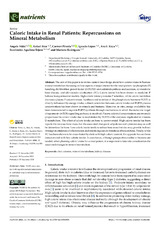Mostrar el registro sencillo del ítem
Caloric Intake in Renal Patients: Repercussions on Mineral Metabolism
| dc.contributor.author | Vidal, Ángela | |
| dc.contributor.author | Ríos, Rafael | |
| dc.contributor.author | Pineda, Carmen | |
| dc.contributor.author | López, Ignacio | |
| dc.contributor.author | Raya, Ana I. | |
| dc.contributor.author | Aguilera Tejero, Escolástico | |
| dc.contributor.author | Rodríguez, Mariano | |
| dc.date.accessioned | 2020-12-23T11:27:15Z | |
| dc.date.available | 2020-12-23T11:27:15Z | |
| dc.date.issued | 2020 | |
| dc.identifier.uri | http://hdl.handle.net/10396/20942 | |
| dc.description.abstract | The aim of this paper is to review current knowledge about how calorie intake influences mineral metabolism focussing on four aspects of major interest for the renal patient: (a) phosphate (P) handling, (b) fibroblast growth factor 23 (FGF23) and calcitriol synthesis and secretion, (c) metabolic bone disease, and (d) vascular calcification (VC). Caloric intake has been shown to modulate P balance in experimental models: high caloric intake promotes P retention, while caloric restriction decreases plasma P concentrations. Synthesis and secretion of the phosphaturic hormone FGF23 is directly influenced by energy intake; a direct correlation between caloric intake and FGF23 plasma concentrations has been shown in animals and humans. Moreover, in vitro, energy availability has been demonstrated to regulate FGF23 synthesis through mechanisms in which the molecular target of rapamycin (mTOR) signalling pathway is involved. Plasma calcitriol concentrations are inversely proportional to caloric intake due to modulation by FGF23 of the enzymes implicated in vitamin D metabolism. The effect of caloric intake on bone is controversial. High caloric intake has been reported to increase bone mass, but the associated changes in adipokines and cytokines may as well be deleterious for bone. Low caloric intake tends to reduce bone mass but also may provide indirect (through modulation of inflammation and insulin regulation) beneficial effects on bone. Finally, while VC has been shown to be exacerbated by diets with high caloric content, the opposite has not been demonstrated with low calorie intake. In conclusion, although prospective studies in humans are needed, when planning caloric intake for a renal patient, it is important to take into consideration the associated changes in mineral metabolism. | es_ES |
| dc.format.mimetype | application/pdf | es_ES |
| dc.language.iso | eng | es_ES |
| dc.publisher | MDPI | es_ES |
| dc.rights | https://creativecommons.org/licenses/by/4.0/ | es_ES |
| dc.source | Nutrients 13(1), 18 (2021) | es_ES |
| dc.subject | Diet | es_ES |
| dc.subject | Calories | es_ES |
| dc.subject | Mineral metabolism | es_ES |
| dc.subject | Kidney disease | es_ES |
| dc.title | Caloric Intake in Renal Patients: Repercussions on Mineral Metabolism | es_ES |
| dc.type | info:eu-repo/semantics/article | es_ES |
| dc.relation.publisherversion | http://dx.doi.org/10.3390/nu13010018 | es_ES |
| dc.relation.projectID | Instituto de Salud Carlos III. PI17/00169 | es_ES |
| dc.rights.accessRights | info:eu-repo/semantics/openAccess | es_ES |

